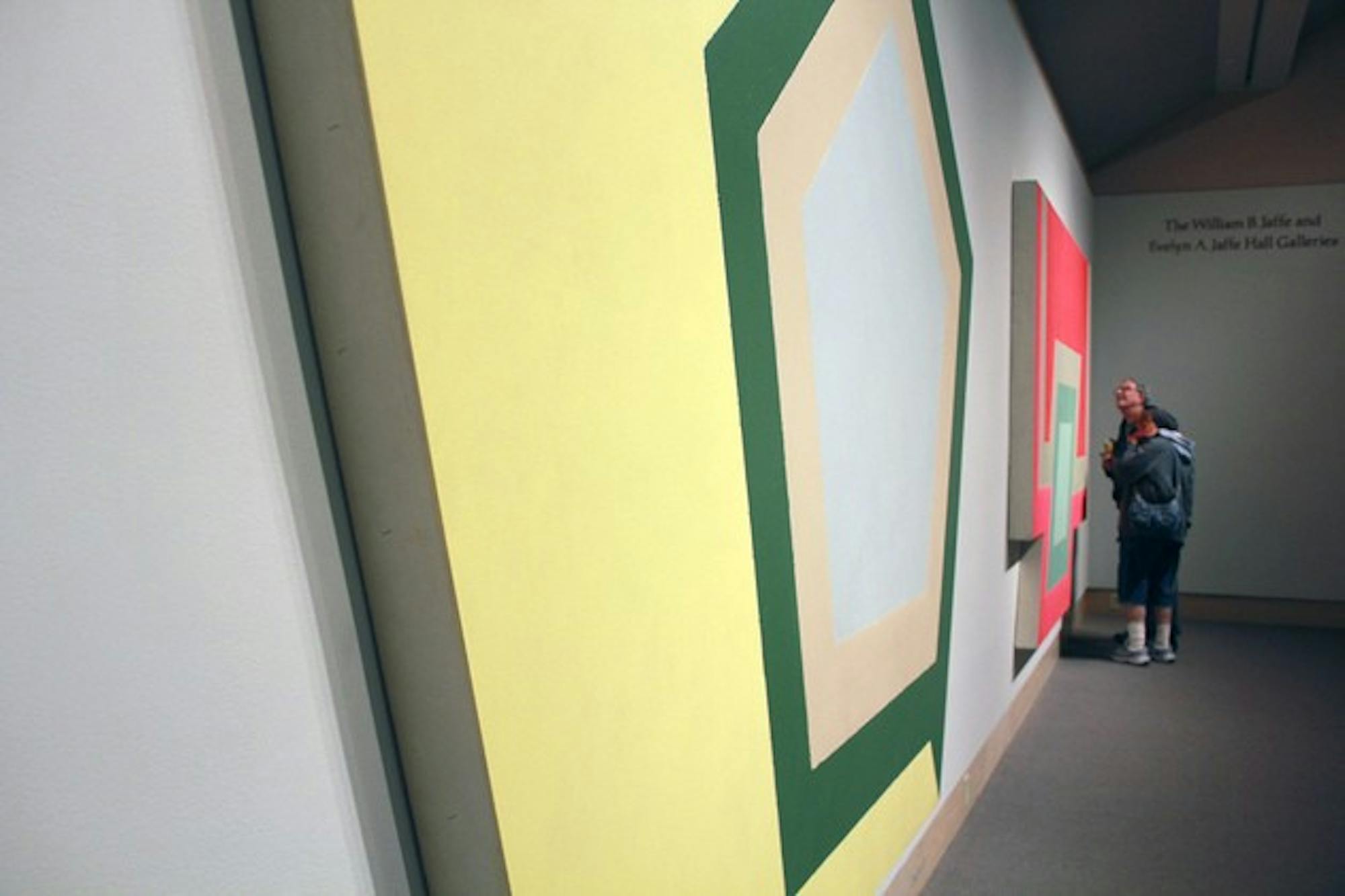Stella's relationship with the College began in 1963, when he came to campus as an artist-in-residence, the artist said in an interview with The Dartmouth. During his tenure at Dartmouth, Stella created the "Dartmouth Paintings," a series of abstract works named after cities in Florida. Similarly, he named the works in his 1965-66 "Irregular Polygon" series after small towns in New Hampshire, which the New England-born artist remembered from trips he took with his father in his childhood. In 1985, the year when the Hood Museum first opened its doors, Stella spoke at Dartmouth's annual convocation ceremony and received an honorary degree. Thus, his return to campus this October for the opening of the exhibit and as a Montgomery Fellow provides a nice symmetry in the artist's career.
In creating the series featured in the Hood's exhibit, Stella composed 11 different "irregular polygons" polygons that, according to Kennedy's book, do not have equal sides and angles. For each polygon, Stella created four distinct paintings, each using a different color combination for the shapes within the polygon, bringing the total number of works in the series to 44. The current exhibit displays one painting of each different polygon.
According to Kennedy, part of Stella's pull lies in this innovative use of color. In an interview with The Dartmouth, Kennedy described Stella as a "great colorist," emphasizing that the four works each of which has different color combinations and the same irregular polygon shape could not be described as four versions of the same painting. Instead, Kennedy explained, the different color choices work together to create different visual effects, resulting in four highly variable, individualized works.
To color his polygons, Stella used commercial paints, rather than art paints.
"It makes a painting surface with less absorption," Stella explained. "It pushes everything forward. It stops just short of reflection."
The iconic work "Chocorua IV" (1966) is among the paintings in the exhibit. The shape an equilateral triangle penetrating the top left corner of a square exemplifies Stella's deconstruction of and play with traditional shapes. The construction is simple, made of utterly familiar forms; and yet the piece is immediately striking.
"Some things are more immediately successful, some things work better than others. Chocorua' was not so explicable but was immediately good," Kennedy said during the opening lecture, quoting Stella.
Unfamiliar to the eye, Stella's newly created shape is challenging, even troubling. What do we or can we make of this new shape, and is it a shape at all? This notion of inventing entirely new shapes is, according to Kennedy, part of what makes Stella's work so revolutionary.
"After thousands and thousands of years of artmaking, it wasn't until 1965 that the very first shaped series of paintings which were intentionally irregularly shaped was created," Kennedy explained.
Before Stella, no one had come up with such an idea, Kennedy said, explaining that because the irregular polygon shapes were completely original, the N.H. town names the artist ascribed to his works "became the names for those particular shapes, which had never been seen before."
The originality of Stella's work aligns with his professed artistic goal to create completely new art.
"The highest accolade you can get is that your work is without precedent," Stella said.
Stella's paintings boast many other exciting visual features. In particular, Stella's employment of white lines and mitring were subjects of praise in Kennedy's opening lecture on the exhibition. Taking a cue from Matisse's famous "The Red Studio" (1911), Stella uses white lines to distinguish among the colorful shapes in his "Irregular Polygons." He achieved this effect by using tape to demarcate the different shapes he painted within the irregular polygons, then pulling the tape off to reveal the white canvas underneath. This technique creates a more natural and visually intriguing space between shapes viewers who examine "Irregular Polygons" up close can find imperfections where the tape created an uneven line.
Stella's use of mitred lines helps to both enhance and relieve visual tensions among shapes within "Irregular Polygons." In "Chocorua," for example, "The mitring of the lightning-like band that cushions the triangle reinforces the larger area's ability to contain the triangle, rather than appear to be seeking to eject it," according to the exhibition guide released by the Hood.
While the Hood's new exhibition is primarily focused on the 11 paintings from the "Irregular Polygon" series, it also features preparatory drawings for "Irregular Polygons," the print series "Eccentric Polygons" (1974) and two sculptures from Stella's recent "Polychrome Reliefs." Comparing the "Irregular Polygons" to Stella's more recent three-dimensional work allows viewers to see both how Stella's work has changed over the years and how it has remained the same. Stella's newest works are traditionally classified as sculptures, but Kennedy said he believes that, because of certain features of the sculptures, Stella has retained his identity as a painter. Stella's techniques may have changed over the years, but his essential artistic philosophy appears to have remained the same.
"Frank Stella: Irregular Polygons" will be on display through March 13. Stella will be on campus Oct. 17-24 and will participate in a question-and-answer session Oct. 21 at 4:30 p.m. in Spaulding Auditorium.




